 Purdue University - Extension - Forestry and Natural Resources
Purdue University - Extension - Forestry and Natural Resources
Got Nature? Blog
Wild Bulletin, Indiana Department of Natural Resources (DNR) Fish and Wildlife: IN DNR providing public online forms to submit your comments regarding proposed changes on two regulations for the state.
Public Comment Period Open for Proposed Changes to Deer Hunting Rules:
Indiana’s Natural Resources Commission (NRC) has opened a public comment period for proposed changes to Indiana’s deer hunting rules before they vote on the proposed changes. Most proposed changes intend to simplify Indiana’s deer hunting rules so they are easier to understand.
Public comments can be submitted online. Locate the “Submit Comments Here” link in the Rules Docket for the Deer Hunting Rule Amendments Proposal. The deadline for public comments is March 20. The public hearing will be held on Wednesday, March 20, from 4–8 p.m. ET both online and in person at the Fort Harrison State Park Inn’s Roosevelt Ballroom. To attend the public hearing online, go to Microsoft Teams and enter Meeting ID: 296 491 887 327, Passcode: xTCuyW starting at 4 p.m. ET on March 20.
For more information on the proposed rule changes, visit the Indiana Department of Natural Resources’ rule and regulations changes web page. Questions about the proposed deer hunting rule changes should be directed to 812-334-3795 or indeerhotline@dnr.IN.gov.
Public Comment Period Open for Proposed Changes to River Otter Trapping Rules:
The Natural Resources Commission (NRC) has opened a public comment period for proposed changes to Indiana’s river otter trapping rule before they vote on final adoption of the proposed changes.
Indiana DNR is proposing to open otter trapping statewide but keep all other otter regulations the same. The proposed changes will allow otters to be trapped statewide, allowing people to handle emerging wildlife conflicts in all counties and simplify the otter regulations. The DNR is confident the change will not negatively affect river otter populations, which staff will continue to monitor.
Public comments can be submitted online. Locate the “Comment on this rule” link in the Rule Docket for the River Otter Trapping Rule. The deadline for public comments is April 11.
Questions about the proposed otter trapping rule changes should be directed to Geriann Albers at 812-822-3304 or galbers@dnr.IN.gov. Visit the Indiana Department of Natural Resources website for more information on the proposed rule changes.
To learn more please visit Indiana Natural Resources Commission – Rulemaking Docket.
Resources:
Creating a Wildlife Habitat Management Plan for Landowners, The Education Store, Purdue Extension’s resource center
A Template for Your Wildlife Habitat Management Plan, The Education Store
Wildlife Habitat Hint: Trail Camera Tips and Tricks, Got Nature? Blog
Forest Improvement Handbook, The Education Store
Designing Hardwood Tree Plantings for Wildlife – The Education Store
ID That Tree – YouTube Playlist
Hunting Guide for 2023-2024, Indiana Department of Natural Resources
How to Score Your White-tailed Deer, video, The Education Store, Purdue Extension Resource Center
White-Tailed Deer Post Harvest Collection, video, The Education Store
Age Determination in White-tailed Deer, video, The Education Store
How to Build a Plastic Mesh Deer Exclusion Fence, The Education Store
Forest Management for Reptiles and Amphibians: A Technical Guide for the Midwest, The Education Store
Ask the Expert: Hardwood Ecosystem Experiment – Birds and Salamander Research, Purdue Extension – FNR
A Template for Your Wildlife Habitat Management Plan, The Education Store
Managing Your Woods for White-Tailed Deer, The Education Store
Indiana Department of Natural Resources
Indiana Arborist Association
P.O. Box 946
Cicero, IN 46034
Press Release February 14, 2024
The Indiana Arborist Association (IAA) has received funding from Indiana Department of Natural Resource’s Community and Urban Forestry program to launch the first ever workforce development program dedicated to training certified arborists from underserved and disadvantaged communities in Northwest Indiana (NWI). This grant is funded through the U.S. Department of Agriculture (USDA) Forest Service Urban & Community Forestry program.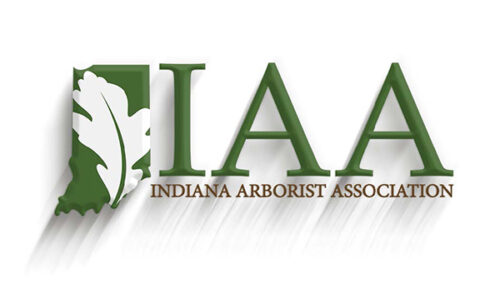
The IAA strives to enhance the quality of life for Indiana residents by encouraging the planting, maintenance and preservation of trees and promoting the advantages of working with qualified professional arborists who use current industry standards. Ashley Mulis, who will serve as program manager for the initiative is excited for this opportunity. “The need for qualified arborists in NWI has consistently surpassed the number of available practitioners. The IAA is thrilled to be able to launch such an important program in an area of the state that has historically suVered from both lack of tree canopy and certified arborists.” The State of Indiana along with many states across the U.S. struggle to fill jobs in the green industry with skilled labor. To eVectively manage the urban forest, communities need skilled practitioners in arboriculture who understand the biology, management needs, and critical ecosystem services trees provide.
The Arborist Apprenticeship program will be a collaborative eVort with several partners in NWI including Purdue University Northwest (PNW), Purdue Extension, and the Center for Workforce Innovation who will assist in the education and training of arborists who will go on to care for trees in disadvantaged communities of NWI. PNW Chancellor Kenneth Holford had this to say of the program partnership with IAA: “Purdue University Northwest is pleased to be a partner in this innovative workforce development program aimed at filling a growing and increasingly important gap in local talent to enhance the urban forests and ecosystems throughout Northwest Indiana. This program is consistent with PNW’s goal of building a strong, skilled, and sustained workforce for the region.”
Northwest Indiana has been the focus of a large multi-year tree planting eVort led by CommuniTree. CommuniTree is NWI’s flagship urban and community forestry program that brings non-profits, communities, government agencies, universities, and businesses together to deliver a shared goal of creating a more diverse, healthy, and equitable urban forest across the region. As of 2024, CommuniTree partners including the Northwestern Indiana Regional Planning Commission (NIRPC), the Student Conservation Association (SCA), the US Forest Service (USFS), the NWI Urban Waters Federal Partnership (NWI UWFP) and others, have planted over 10,000 trees across the region. These trees require professional management provided by trained certified arborists. “CommuniTree, an outgrowth of the NWI UWFP, has created an unparalleled opportunity for workforce development initiatives to continue to grow, sustain and diversify urban forests in the region by drawing on the strengths that regional partnerships bring to the table. The NWI UWFP fully supports the IAA in their endeavor to provide professionally trained and certified Arborists for NWI.” Victoria Wittig, Ph.D., the Northwest Indiana Urban Waters Federal Partnership Ambassador. “The Center of Workforce Innovations applauds IAA on their work to bring this transformational program to NWI. Disadvantaged communities often bear the brunt of climate change impacts and environmental degradation. Training individuals from these communities in climate adaptation and mitigation strategies can lead to healthier local environments. The CommuniTree program, in conjunction with this Arborist Apprenticeship program specifically aims to not only reverse these environmental impacts but also equip residents of those same communities with the skills and knowledge necessary to thrive in the emerging green economy through a proven work-and-learn model.” Shaun SahlhoV, Director of Planning and Fundraising at the Center of Workforce Innovations.
To learn more about the Indiana Arborist Association visit www.indiana-arborist.org or email info@indiana-arborist.org.
Media Contact: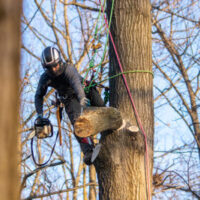
Ashley Mulis, Business Manager
Indiana Arborist Association
Email: ashley@indiana-arborist.org
Phone: (219) 295-0048
Lindsey Purcell, Executive Director
Indiana Arborist Association
Email: lindsey@indiana-arborist.org
Phone: (219) 295-0048
Other Resources:
Urban Forestry, Playlist, Purdue Extension – Forestry and Natural Resources (FNR) YouTube Channel
How to Find an Arborist Near You!, Purdue Extension – FNR Got Nature? Blog
What is Urban Forestry? Do You Know?, Purdue Extension – FNR Got Nature? Blog
Urban Forestry Minor, Purdue Forestry & Natural Resources (FNR)
Storms Can Cause Damage and Tree Cleanup, What You Need to Know, Purdue Extension – FNR Got Nature? Blog
Purdue Landscape Report, Purdue Science-Based Midwest Landscaping
Forest Improvement Handbook, The Education Store, Purdue Extension’s resource center
Investing in Indiana Woodlands, The Education Store
Woodland Wildlife Management, The Education Store
ID That Tree, Playlist, Purdue Extension – Forestry & Natural Resources (FNR) YouTube Channel
Are you an Indiana teacher who is looking to incorporate natural resources, forest ecology and forest management into your curriculum?
Apply now for the Indiana Natural Resources Teacher Institute, an immersive multi-day professional development workshop that will bring 18 teachers from across the state to Morgan-Monroe State Forest to see firsthand how forestry works in Indiana. Sessions from June 24 to 28 will include tours of public and private forest lands, forest industry facilities, and information about forestry research in Indiana.
The goal of the institute, which is co-hosted by the Indiana Department of Natural Resources and Purdue Forestry and Natural Resources Extension, is to provide Indiana teachers with knowledge, skills and tools to effectively teach their students about forest ecology and forest management practices. The forest environment becomes the basis for integrating the learning of many subject areas, including environmental science, biology, natural resources, and social science. The NRTI incorporates STEM concepts and principles throughout the sessions and empowers educators to foster conceptual learning, critical thinking and decision-making skills in their classrooms.
The Natural Resources Teacher Institute emphasizes the importance of conservation of natural resources with special attention given to Indiana’s forests and forest products. The project-based approach integrates hands-on study of the natural and cultural resources of the local community, addresses concepts in ecology, sense of place, civics, economics and forest land management and stewardship.
Participants will develop a curriculum project about forests or forestry for their classrooms. Participants will earn 30+ Professional Growth Points and receive a stipend upon documentation of implementing curriculum project. Concepts are linked to the Indiana Learning Standards and participants are provided resources and training from Project Learning Tree as well as forestry equipment kits.
The 2024 edition of the NRTI will begin on Monday, June 24 at 1:00 pm and conclude on Friday, June 28 at noon. The base of operations will be the Forestry Training Center at Morgan-Monroe State Forest near Martinsville. Teachers will stay in the Training Center, sharing one of the 10 sleeping rooms. Meals will be provided.
Interested educators must complete an application and submit it by the deadline of March 22, 2024. Successful applicants will be notified by April 1, 2022. The institute is limited to 18 participants per session. There is no cost for participants. Those accepted will be required to pay a $50 deposit, which will be refunded at the end of the program. Participants will receive a stipend when documentation is provided that they have implemented their curriculum project with their students.
- Attendees must be available to participate in all days of the institute. (Individual participation only – spouses and/or children, etc., are not permitted.)
- Participants must be able to actively participate in all activities, which will include walking, hiking, summer temperatures, insects, etc. Reasonable accommodations will be made for individuals with disabilities who may need assistance.
- Participants must have the ability to implement a curriculum project in their educational setting.
For more information and to request an application for the NRTI, contact Project Learning Tree Coordinator Lexi Eiler via email at leiler@dnr.in.gov or via phone at 463-253-8835.
To get a glimpse at the curriculum and also feedback from past participants, read NRTI Takes Forestry to the Classroom.
To register, please fill out the NRTI Application.
Resources:
Purdue Forestry and Natural Resources Facebook Page
Project Learning Tree
Indiana Department of Natural Resources Division of Forestry
The Nature of Teaching, Purdue Department of Forestry and Natural Resources
The Nature of Teaching: Trees of the Midwest, The Education Store
The Nature of Teaching: Adaptations for Aquatic Amphibians, The Education Store
Trees of the Midwest Webinar, Nature of Teaching YouTube channel
Indiana Forestry Educational Foundation, Indiana Forestry & Woodland Owners Association
Forest/Timber, Playlist, Purdue Extension – Forestry and Natural Resources YouTube Channel
Natural Resources Teacher Institute Takes Forestry to the Classroom, Purdue FNR News
Purdue Extension
Lexi Eiler, Coordinator
Indiana Project Learning Tree
Lenny Farlee, Sustaining Hardwood Extension Specialist
Purdue University Department of Forestry and Natural Resources
Wild Bulletin, Indiana Department of Natural Resources (DNR) Fish and Wildlife: Looking to build habitat that benefits wildlife species near you? February is a great time to complete winter habitat improvement projects, such as frost seeding native forbs, edge feathering forest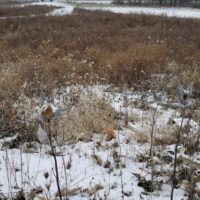 boundaries, prescribe-burning warm-season grass, and removing invasive species.
boundaries, prescribe-burning warm-season grass, and removing invasive species.
DNR’s wildlife habitat fact sheets can teach you the best techniques for your desired management practices. Need more information for your unique property? Contact your district’s Wildlife Biologist, who can meet with you to provide suggestions on wildlife habitat improvements based on your specific goals.
To learn more please visit DNR: Wildlife Habitat Fact Sheets.
Resources:
Frost Seeding to Establish Wildlife Food Plots and Native Grass and Forb Plantings – The Education Store, Purdue Extension’s resource center
Tips for Evaluating a First Year Native Grass and Forb Planting, Got Nature? – Purdue Extension-Forestry & Natural Resources (FNR)
Wildlife Habitat Hint: Tips for Evaluating a First Year Native Grass and Forb Plantings, Purdue Extension – FNR YouTube Channel
Calibrating a No-Till Drill for Conservation Plantings and Wildlife Food Plots – The Education Store
Drone Seeding Native Grasses and Forbs: Project Overview & Drone Setup, Purdue Extension – FNR YouTube channel
Drone Seeding Native Grasses and Forbs: Seed Mixing, Loading the Hopper, Programming the Route, Purdue Extension – FNR YouTube channel
Drone Seeding Native Grasses and Forbs: Recapping the Project, Purdue Extension – FNR YouTube channel
Renovating Native Warm-season Grass Stands for Wildlife, The Education Store
Forest Improvement Handbook, The Education Store
Ordering Seedlings from the State Forest Nursery System, Got Nature? – Purdue Extension-Forestry & Natural Resources (FNR)
Designing Hardwood Tree Plantings for Wildlife – The Education Store
ID That Tree – YouTube Playlist
Forest Management for Reptiles and Amphibians: A Technical Guide for the Midwest, The Education Store
Ask the Expert: Hardwood Ecosystem Experiment – Birds and Salamander Research, Purdue Extension – FNR
A Template for Your Wildlife Habitat Management Plan, The Education Store
Managing Your Woods for White-Tailed Deer, The Education Store
Woodland Stewardship for Landowners, Playlist, Purdue Extension – FNR YouTube channel
Winter Weather Tree Tips, Got Nature? Blog, Purdue Extension – FNR
Indiana Department of Natural Resources
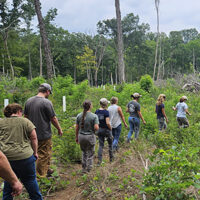 The Hardwood Tree Improvement and Regeneration Center (HTIRC) was conceived in 1998 to address a perceived void in hardwood tree improvement research in the Central Hardwood Forest Region (CHFR) and is committed to enhancing the productivity and quality of CHFR trees and forests for the economic and environmental benefits they provide. Scientists at the HTIRC are using conventional tree improvement breeding as well as molecular and genetic technologies to improve the wood quality, growth characteristics, and insect and disease resistance of trees like black walnut, black cherry, red and white oaks, butternut and American chestnut. Research in tree breeding, tree nursery practices, tree plantation establishment and management, and Central Hardwoods silvicultural systems is aimed at increasing the regeneration success rate for high-quality hardwood trees and forests.
The Hardwood Tree Improvement and Regeneration Center (HTIRC) was conceived in 1998 to address a perceived void in hardwood tree improvement research in the Central Hardwood Forest Region (CHFR) and is committed to enhancing the productivity and quality of CHFR trees and forests for the economic and environmental benefits they provide. Scientists at the HTIRC are using conventional tree improvement breeding as well as molecular and genetic technologies to improve the wood quality, growth characteristics, and insect and disease resistance of trees like black walnut, black cherry, red and white oaks, butternut and American chestnut. Research in tree breeding, tree nursery practices, tree plantation establishment and management, and Central Hardwoods silvicultural systems is aimed at increasing the regeneration success rate for high-quality hardwood trees and forests.
In this Fall 2023 HTIRC Newsletter you will find current research happenings that include:
- Douglass Jacobs Co-leader on Assessment of At-Risk Forest Trees – Douglass Jacobs of the HTIRC and Kasten Dumroese of the U.S. Forest Service led a team of 19 co-authors, including scientists, land managers and regulators, in presenting their findings on biotechnological risk assessment and forest tree restoration
- Annual Report Available for 2022 – The annual report outlining HTIRC research projects, strategic directions and accomplishments is now available on the HTIRC website at Annual Report.
- Indiana Conservation Partnership Training – In August of 2023, Extension and Property Management staff from HTIRC and Purdue Forestry and Natural Resources provided hands-on training days at the Purdue FNR Martell Forest and Southeast Purdue Ag Center properties for members of the Indiana Conservation Partnership, including USDA NRCS, Indiana SWCD, Indiana DNR, and Purdue Extension employees.
- HTIRC Participates in Walnut Council Annual Conference – Several members of the HTIRC staff helped organize and presented at the annual National Walnut Council conference in Columbia, Missouri in July or 2023. This year was a unique event with three organizations joining forces for an impressive array of presentations an field tours.
- Forgey Wins “Sagamore of the Wabash” Award – Michael Forgey, a resident of New Palestine and a seasoned Rush County farmer, was honored with the prestigious “Sagamore of the Wabash” award by Governor Eric Holcomb at the Forgey Tree Farm in Rush County, Indiana on November 1, 2023.
- The HTIRC 2023 Seed Harvest – Seed production is a crucial component of the HTIRC’s improvement program, for without it there is no progeny testing or distribution of improved genetics to the public. This year, a droughty spring and early summer was followed by an unusually wet July, stimulating a bumper crop in the HTIRC’s orchards.
View the full Fall 2023 HTIRC Newsletter and meet the new administrative assistant, learn more about the awards received and current research.
Resources:
HTIRC 2020 Annual Report
Hardwood Tree Improvement & Regeneration Center (HTIRC)
Tropical Hardwood Tree Improvement & Regeneration Center (tropHTIRC)
Partners, Purdue Forestry & Natural Resources
An Introduction to Trees of Indiana, The Education Store, Purdue Extension resource center
Native Trees of the Midwest, The Education Store
Shrubs and Woody Vines of Indiana and the Midwest, The Education Store
ID That Tree, Playlist, Subscribe to Purdue Extension – Forestry and Natural Resources YouTube Channel
A Woodland Management Moment, Playlist, Purdue Extension – FNR YouTube Channel
Investing in Indiana Woodlands, The Education Store
Forest Improvement Handbook, The Education Store
Finding help from a professional forester, Indiana Forestry & Woodland Owners Association
District Foresters for 10 plus acres, Indiana Department of Natural Resources
Wood Products, FNR Concentration
Hardwood Tree Improvement Regeneration Center (HTIRC)
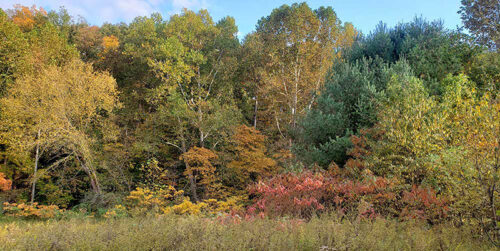 The Indiana Natural Resources Conservation Service (NRCS) is offering an opportunity for landowners to apply for cost assistance with conservation practices like tree planting, forest stand improvement, invasive species control, wildlife habitat improvement and many others.
The Indiana Natural Resources Conservation Service (NRCS) is offering an opportunity for landowners to apply for cost assistance with conservation practices like tree planting, forest stand improvement, invasive species control, wildlife habitat improvement and many others.
U.S. Department of Agriculture, Natural Resources Conservation Service News Release, Indianapolis, IN, October 11, 2023 – Farm Bill program application dates have been set for Indiana’s agricultural producers who want to improve natural resources and address concerns on their land. Curtis Knueven, USDA-Natural Resources Conservation Service (NRCS) Acting State Conservationist, announced that December 8 will be the application deadline for the Environmental Quality Incentives Program (EQIP) and Conservation Stewardship Program (CSP) in Indiana. This year’s funding levels are a historic high for Indiana NRCS, bringing $42 million in EQIP and $22 million in CSP for Indiana landowners.
EQIP is a voluntary conservation program available for agricultural producers. Through EQIP, NRCS provides financial and technical assistance to install conservation practices that reduce soil erosion and sedimentation, improve soil health, improve water and air quality and create wildlife habitat. Also included in this sign up are several state and national initiatives. A full list of initiatives can be found by visiting www.nrcs.usda.gov/programs-initiatives/eqip-environmental-quality-incentives/indiana/environmental-quality-incentives.
“EQIP helps agricultural producers in a manner that promotes agricultural production and environmental quality as compatible goals,” said Knueven. “Farmers can receive assistance to implement structural and management conservation practices that optimize environmental benefits on their working agricultural land while helping to increase their yields.”
CSP is an important Farm Bill conservation program that helps producers who are already practicing good stewardship to take their natural resource management to the next level. The program helps to improve both their agricultural production and provide valuable conservation benefits such as cleaner and more abundant water, as well as healthier soils and better wildlife habitat.
“Whether you are looking to improve grazing conditions, increase crop resiliency, or develop wildlife habitat, we can custom design a CSP plan to help you meet those goals,” Knueven said. “We can help you identify natural resource problems in your operation and provide technical and financial assistance to solve those problems or attain higher stewardship levels in an environmentally beneficial and cost-effective manner.”
While applications are accepted year-round, interested producers should work with their local NRCS staff and apply by December 8 to be considered for the current funding period. Applications received after December 8 will automatically be considered during the next funding cycle.
For more information about Farm Bill programs and other technical and financial assistance available through Indiana NRCS conservation programs, visit www.nrcs.usda.gov/indiana or contact your district conservationist www.farmers.gov/working-with-us/service-center-locator.
Resources:
Woodland Stewadrship for Landowners: EQUP, video, Purdue Extension-Forestry and Natural Resources (FNR) YouTube Channel
Woodland Stewardship for Landowners: Single Tree and Patch-Cut Harvesting, Purdue Extension – FNR Video
Woodland Stewardship for Landowners YouTube Playlist, Purdue Extension – FNR
Woodland Management Moment: Invasive Species Control Process, Purdue Extension – FNR Video
Woodland Management Moment YouTube Playlist, Purdue Extension – FNR
Invasive Species YouTube Playlist, Purdue Extension – FNR
What are invasive species and why should I care?, Got Nature? Blog, Purdue Extension – Forestry and Natural Resources
Report Invasive Species, Purdue Invasive Species
The GLEDN Phone App – Great Lakes Early Detection Network
EDDMaps – Early Detection and Distribution Mapping System
Hardwood Ecosystem Experiment: Uneven-aged Management, Purdue Extension – FNR Video
Hardwood Ecosystem Experiment: Even-aged Management, Purdue Extension – FNR Video
Finding help from a professional forester, Indiana Forestry & Woodland Owners Association
Forest Improvement Handbook, The Education Store, Purdue Extension resource center
Natural Resources Conservation Service
U.S. Department of Agriculture
Lenny Farlee, Extension Forester
Hardwood Tree Improvement & Regeneration Center (HTIRC)
Purdue University Department of Forestry and Natural Resources
MyDNR, Indiana’s Outdoor Newsletter: The Indiana Cooperative Fish and Wildlife Research Unit, or CRU, that Purdue will host, brings together the U.S. Geological Survey, U.S. Fish and Wildlife Service, Purdue University, the DNR, and the Wildlife Management Institute.
Its focus will be on delivering actionable science addressing fish, wildlife, plants, and other natural resources in Indiana and beyond, including the connection between the health of wildlife and the health of people.
The CRU Program is results focused, bringing together natural resource managers and researchers to work as a team to address the most pressing natural resource management needs with science. As such, the partnerships formalized with the creation of CRUs lead to true co-production of research.
“The creation of this new unit is another milestone in the highly successful USGS Cooperative Research Units Program, and we are proud to join the state of Indiana, Purdue University, the USGS, Wildlife Management Institute, and others to address conservation questions facing Indiana and the region,” said U.S. Fish and Wildlife Service Science Applications Program Assistant Regional Director Craig Czarnecki. “We look forward to engaging with the students and professionals at Purdue University as we co-develop scientific research and support the next generation of conservationists.”
But CRUs don’t just tackle management needs. They do so while cultivating the next generation of scientists and resource managers. The new Indiana CRU will focus on education, training, and outreach related to natural resources vital not only to Indiana, but the Midwest and regional economies as well.
Like all CRUs, the Indiana CRU will consist of 2-5 federal scientists along with graduate students, postdoctoral fellows, and administrative specialists. Federal scientists will serve as faculty at Purdue University, teaching graduate-level courses, supervising graduate students and postdocs, offering workshops for students and cooperators, and conducting research on natural resources topics. Once created, each CRU formalizes research priorities, like aquatic conservation or wildlife disease. Indiana CRU partners will decide these in the coming months.
“We look forward to the tremendous opportunity that collaboration with the Indiana CRU will bring to our state and Purdue University,” said Karen Plaut, executive vice president of research at Purdue University. “It will have a direct impact on graduate education as well as research productivity and innovation.”
For full article please visit: The partnership is Indiana’s first U.S. Geological Survey Cooperative Fish and Wildlife Research Unit, Indiana DNR Calendar.
Sign up to receive the MyDNR Newsletter by email: MyDNR Email Newsletter
Resources:
Purdue Announces New USGS Cooperative Research Unit, Purdue Agriculture New
Wildlife Habitat Education Program: Wildlife Identification Guide, The Education Store, Purdue Extension resource center
Wildlife Habitat Education Program – Teaching and Learning Wildlife Management Practices, The Education Store
Wildlife Habitat Evaluation Program: Preparing for the Wildlife Challenge, The Education Store
Developing a Wildlife Habitat Management Plan, The Education Store
Woodland Wildlife Management, The Education Store
Purdue Integrated Deer Mangement Project, Purdue College of Agriculture
Purdue Extension-Forestry and Natural Resources (FNR) Publications
Indiana Pond Fish, Species Identification Card Set, Purdue Extension – Forestry and Natural Resources (FNR)
A Guide to Small-Scale Fish Processing Using Local Kitchen Facilities, The Education Store
Subscribe to Purdue Extension-FNR YouTube Channel
Invasive Species, Playlist, Purdue Extension – FNR YouTube Channel
What are invasive species and why should I care?, Got Nature? Blog, Purdue Extension – Forestry and Natural Resources
Invasive plants: Impact on Environment and People, The Education Store, Purdue Extension’s resource center
Indiana Department of Natural Resources, Department of Fish & Wildlife
 Purdue Agriculture News – Purdue Extension has been selected to support a multistate effort to help rural, tribal and underserved communities access federal funding for energy and environmental improvement efforts.
Purdue Agriculture News – Purdue Extension has been selected to support a multistate effort to help rural, tribal and underserved communities access federal funding for energy and environmental improvement efforts.
The University of Minnesota will lead the effort as an Environmental Justice Thriving Communities Technical Assistance Center (TCTAC) for Region 5 with funding from the U.S. Environmental Protection Agency. Purdue Extension’s Community Development program will provide central support in Indiana to help communities navigate federal grant application systems, identify partners and matching funds, and assist with project design and development.
“Purdue Extension is positioned well to connect with rural and underserved communities across Indiana with staff in all 92 counties,” said Kara Salazar, assistant program leader for Purdue Extension Community Development and sustainable communities extension specialist. “We look forward to working with regional partners as a liaison for communities in need of resources to assist with clean energy and water, affordable and sustainable housing, and addressing legacy pollution.”
Additional partners in Indiana include the North Central Regional Center for Rural Development (NCRCRD), Illinois-Indiana Sea Grant and Purdue Center for Regional Development (PCRD).
Michael Wilcox, associate director of NCRCRD and assistant director and program leader of Purdue Extension Community Development, welcomes interested community partners to reach out to get involved.
“We look forward to connecting with communities across the state while collaborating with our partners across the EPA Region 5. This is another excellent example of states within the north central region working together as partners to address pressing issues while fostering community resilience,” he added.
“Illinois-Indiana Sea Grant is enthusiastic to build on our ongoing programs as we partner on this broad project to help support underserved coastal communities around southern Lake Michigan and throughout the Great Lakes in addressing environmental challenges,” said Tomas Höök, director of Illinois-Indiana Sea Grant and professor in Purdue University’s Department of Forestry and Natural Resources.
Resources:
Implementation Examples of Smart Growth Strategies in Indiana, The Education Store, Purdue Extension’s resource center
Conservation Through Community Leadership, The Education Store
Conservation Through Community Leadership, website, Sustainable Communities Extension Program (SCEP)
Conservation Through Community Leadership, video, Purdue Extension You Tube Channel
Rainscaping Education Program, Purdue Extension
Rainscaping and Rain Gardens, Purdue Extension YouTube Channel
Tipping Point Planner, The Education Store
Tipping Point Planner, Purdue Agriculture YouTube Channel
Enhancing the Value of Public Spaces, The Education Store
Enhancing the Value of Public Spaces: Creating Healthy Communities, The Education Store
Enhancing the Value of Public Spaces Program, video, Purdue Extension YouTube Channel
Community Planning Playlist, Purdue Extension-Forestry & Natural Resources (FNR) YouTube Channel
Indiana Creek Watershed Project – Keys to Success, Partnerships and People, Subscribe to Purdue Extension-FNR YouTube Channel
Abby Leeds, Senior Communications Specialist
Purdue Agricultural Communications
Michael Wilcox, Associate Director & Program Leader
North Central Regional Center for Rural Development (NCRCRD) & Purdue Extension Community Development
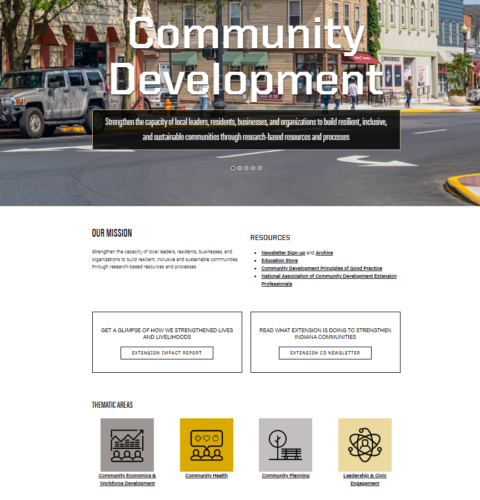 Question: What resources does Purdue Extension have on wind energy/contracts?
Question: What resources does Purdue Extension have on wind energy/contracts?
Answer: Purdue Extension has wind energy resources and information through the Purdue Extension – Community Development program. This program strengthens the capacity of local leaders, residents, businesses, and organizations to build resilient, inclusive and sustainable communities through research-based resources and processes. The team actively partners with a variety of state-level entities, including state agencies, private and nonprofit organizations, as well as universities and colleges. Such partnerships have facilitated the launch of applied research projects, the development of innovative educational programs and the delivering of technical assistance and non-formal education programs that are designed to meet the unique needs of Indiana communities and regions.
Under “Community Planning” you will find the resources and information for Renewable Energy. Learn more about the Purdue Extension Land Use Team as you visit the overview and find contacts, events, publications, general renewable energy, solar and wind resources.
Here are just a few of the resources listed on the Community Development-Community Planning-Wind Energy web page:
Agricultural Impact Statements: Wind Farms – State of Wisconsin Department of Agriculture, Trade and Consumer Protection
This article provides construction recommendations for commercial scale wind farms on farmland located specifically in the state of Wisconsin. This resource has links to licenses, permits, impact statements and groundwater quality reports that all pertain to the impacts of wind turbines on green-fields and the surrounding areas.
An Examination of the Community Level Dynamics Related to the Introduction of Wind Energy in Indiana
A team of researchers from Purdue University focused on where wind farm projects have and have not been located and examined socio-economic conditions that have resulted since the wind farms were (or were not) installed and made operational.
Blowing in the Wind: The Answer to Farmland Preservation – University of Michigan
This resource highlights the ways commercial wind farms can be used to preserve farmland and farming communities. This resource also emphasizes that wind farms are another source of income for farmers without having to sell their land.
Does my Land Qualify for a Wind Lease, LandGate Resources
This article highlights the requirements of a proper site for a commercial wind farm. These requirements include acreage, power grid access and the quality of the land. Included is a wind land estimator, designed to provide a rough estimate of a possible wind lease.
Sample Zoning for Wind Energy Systems – Michigan State University Extension
This publication presents a zoning ordinance sample amendment for utility-scale wind energy systems and smaller wind electric generation systems for an individual business or home.
These resources are just a glimpse from the Community Development program which shares many aspects of wind energy, along with other community planning, community economics and workforce development, community health, leadership and civic engagement. If you have further questions, feel free to reach out to the Renewable Energy Team.
Other Resources:
Environmental Planning in Community Plans, The Education Store, Purdue Extension’s resource center
Enhancing the Value of Public Spaces: Creating Healthy Communities, The Education Store
Conservation through Community Leadership, The Education Store
Tree Installation: Process and Practices, The Education Store
Planting Forest Trees and Shrubs in Indiana, The Education Store
Planting Your Tree Part 1: Choosing Your Tree, Video, Purdue Extension – Forestry and Natural Resources YouTube Channel
Tipping Point Planner
Sustainable Communities Extension Program
Subscribe – Purdue Extension – Forestry and Natural Resources YouTube Channel
Purdue Extension-Forestry and Natural Resources Calendar, workshops and Conferences
Michael Wilcox, Program Leader
Purdue Extension Community Development
Kara Salazar, Assistant Program Leader for Community Development and Sustainable Communities Extension Specialist
Purdue Forestry and Natural Resources/Illinois-Indiana Sea Grant/Purdue Extension
Diana Evans, Extension and Web Communication Specialist
Purdue University Department of Forestry and Natural Resources
Kara Salazar has been promoted to Assistant Program Leader for Purdue Extension Community Development. She has served in this role part-time but will now be fully dedicated to this program area. Kara will maintain her 25% appointment with Illinois-Indiana Sea Grant (IISG) and serve on the Agriculture Natural Resources (ANR) Extension Advisory Committee. She will still be located in the Forestry Building (FORS 308) and affiliated with the Department of Forestry and Natural Resources (FNR).
Working with multidisciplinary teams, Kara oversees the development and delivery of programs to support environmental planning, community development, and sustainable development strategies in communities across Indiana and the Great Lakes states. Kara provides leadership to the Purdue Extension Community Development Program and serves as a liaison between Illinois-Indiana Sea Grant and Purdue Extension.
Kara has a B.S. in public affairs and environmental science and a M.P.A. in natural resources management and nonprofit management from the Indiana University School of Public and Environmental Affairs. She also received a M.S. Ed . degree from the IU School of Education at Indiana University-Purdue University Indianapolis (IUPUI) with concentrations in community building and science education. Additionally, she is a Ph.D. candidate in Natural Resources Social Science at Purdue University. Kara is a member of the American Institute of Certified Planners (AICP), a Climate Change Professional (CC-P), and a Professional Community and Economic Developer (PCED) with credentials from LEED AP Neighborhood Development, the National Green Infrastructure Certification Program (NGICP), and the National Charrette institute.
Congratulations to Kara in her new position as she continues to move Purdue Extension and IISG forward with her expertise and team building.
Check out Kara’s lead role in the following programs and learn about the vast resources available:
Purdue Extension Community Development – strengthens the capacity of local leaders, residents, businesses, and organizations to build resilient, inclusive and sustainable communities through research-based resources and processes. Examples of a few of the programs and resources available include: Leadership and Civic Engagement, Community and Organizational Planning, Economic and Business Development.
Illinois-Indiana Sea Grant (IISG) – utilizes research, outreach, and education to bring the latest science to Great Lakes communities and their residents. By connecting decision-makers with science, we help strengthen and preserve ecosystems and communities in southern Lake Michigan and beyond.
Agriculture & Natural Resources (ANR), Purdue Extension – ANR Educators serve as research based, unbiased information source for county and state constituents on a variety of topics including: crops, ag business, livestock, natural resource, horticulture, small farms, urban ag, pesticide use, and land conservation.
Purdue Extension – a leader in providing relevant, high-impact educational programs that transform he lives and livelihoods of individuals and communities in Indiana and the world. Purdue Extension – Forestry & Natural Resources (FNR) is a branch of the Cooperative Extension Service/Purdue Extension. FNR Extension provides resources for aquaculture, fish management, urban and forestry management, natural re source planning, wildlife, and sustainable biomaterials. We encourage you to browse, download free publications, utilize our Ask an Expert, subscribe to Got Nature? newsletter and view upcoming workshops.
Sustainable Communities Extension Program (SCEP) – provides multidisciplinary teams focusing in the following areas: Placemaking and Enhancing the Value of Public Spaces; Land use Planning Education; Green Infra structure; Community Development; American Citizen Planner; Facilitation and Strategic Planning; Conservation Through Community Leadership; Rainscaping Education and Tipping Point Planner.
More Resources including Kara’s publications and videos:
Implementation Examples of Smart Growth Strategies in Indiana, The Education Store, Purdue Extension’s resource center
Conservation Through Community Leadership, The Education Store
Climate Change and Sustainable Development, The Education Store
Climate Change: Are you preparing for it?, The Education Store
Tipping Point Planner, The Education Store
Enhancing the Value of Public Spaces, The Education Store
Enhancing the Value of Public Spaces: Creating Healthy Communities, The Education Store
One Water Approach to Water Resources Management, The Education Store
Rainscaping Education Program, Purdue Extension
Conservation Through Community Leadership, Sustainable Communities Extension Program (SCEP)
Community Planning Playlist, Purdue Extension-Forestry & Natural Resources (FNR) YouTube Channel
Rainscaping and Rain Gardens, Purdue Extension YouTube Channel
Conservation through Community Leadership, Purdue Extension You Tube Channel
Enhancing the Value of Public Spaces Program, Purdue Extension YouTube Channel
Tipping Point Planner, Purdue Agriculture YouTube Channel
Indiana Creek Watershed Project – Keys to Success, Partnerships and People, Purdue Extension You Tube Channel
Subscribe to Purdue Extension – Forestry and Natural Resources YouTube Channel
Diana Evans, Extension and Web Communication Specialist
Purdue University Department of Forestry and Natural Resources
Recent Posts
- Natural Resources Commission Updates – Wild Bulletin
Posted: March 4, 2024 in Forestry, How To, Land Use, Natural Resource Planning, Plants, Wildlife, Woodlands - IAA Receives $250,000 Grant for Arborist Apprenticeship
Posted: February 21, 2024 in Forestry, Forests and Street Trees, Natural Resource Planning, Urban Forestry, Wildlife, Woodlands - Indiana Natural Resources Teacher Institute Workshop – Welcome to the Forest!
Posted: February 15, 2024 in Forestry, Natural Resource Planning, Nature of Teaching, Plants, Wildlife, Woodlands - Build a Better Habitat for Wildlife This Winter – Wild Bulletin
Posted: February 1, 2024 in Forestry, How To, Land Use, Natural Resource Planning, Plants, Wildlife, Woodlands - Hardwood Tree Improvement Regeneration Center (HTIRC) Shares Fall Newsletter, Research and Outreach
Posted: December 13, 2023 in Forestry, Land Use, Natural Resource Planning, Woodlands - Cost Assistance for Landowners Planning Conservation Practices
Posted: October 13, 2023 in Forestry, Invasive Plant Species, Natural Resource Planning, Woodlands - MyDNR: New multi-agency research partnership to benefit Indiana’s wildlife and wild places
Posted: September 7, 2023 in Aquaculture/Fish, Aquatic/Aquaculture Resources, Forestry, Natural Resource Planning, Plants, Wildlife, Woodlands - Purdue Extension to Connect Underserved Communities with Funding for Energy and Environmental Improvements
Posted: June 6, 2023 in Community Development, How To, Natural Resource Planning - Question: what resources do you have on wind energy, contracts?
Posted: April 11, 2023 in How To, Land Use, Natural Resource Planning - Kara Salazar Promoted to Aid in Leading Community Development
Posted: March 27, 2023 in Aquaculture/Fish, Aquatic/Aquaculture Resources, Gardening, How To, Land Use, Natural Resource Planning
Archives
Categories
- Alert
- Aquaculture/Fish
- Aquatic/Aquaculture Resources
- Ask the Expert
- Christmas Trees
- Community Development
- Disease
- Drought
- Forestry
- Forests and Street Trees
- Gardening
- Got Nature for Kids
- Great Lakes
- How To
- Invasive Animal Species
- Invasive Insects
- Invasive Plant Species
- Land Use
- Natural Resource Planning
- Nature of Teaching
- Plants
- Podcasts
- Ponds
- Publication
- Safety
- Spiders
- Timber Marketing
- Uncategorized
- Urban Forestry
- Webinar
- Wildlife
- Wood Products/Manufacturing
- Woodland Management Moment
- Woodlands